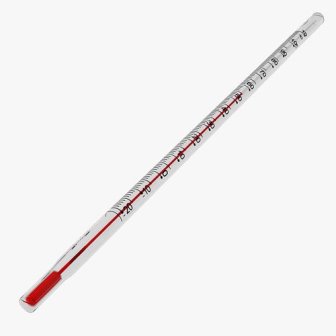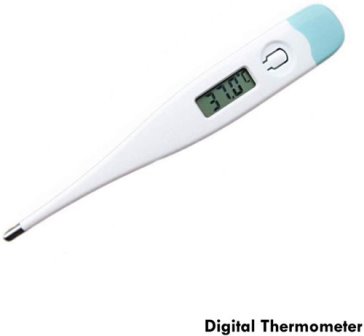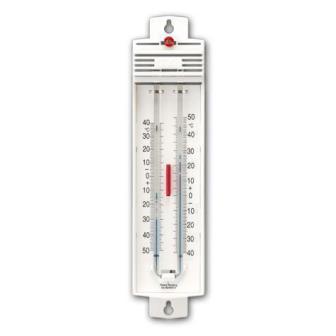Types of Thermometer












Types of Thermometer
Thermometer:
Thermometer is a device which is used to measure temperature. Thermometer is made of a long narrow glass tube; with a bulb at one end. The narrow tube appears as a continuous silver line; because it is filled with mercury. Mercury is a metal which is in liquid state at room temperature and it readily expands or contracts at the slightest change in temperature. Hence, mercury is used in thermometer.
Types of Thermometer:
A. Laboratory Thermometer: Laboratory thermometer is used to measure the temperature. The scale of temperature is graduated generally from –10°C to 110°C over the glass tube. Each division of temperature scale is further divided into 10 parts to read fraction of temperature.

B. Clinical Thermometer: Clinical thermometer is used to measure the body temperature. The scale of temperature is graduated from 35°C to 42°C and or from 94°F to 108°F. The temperature of human body always remains within this range and this is the range on the clinical thermometer. There is a kink make near the bulb of clinical thermometer which prevents the automatic fall of mercury level.

C. Digital Thermometer: In digital thermometer, reading of temperature is displayed digitally as in digital watches. This is safer because no mercury is used in this. It is important to note that mercury is a highly toxic substance.

D. Maximum-Minimum Thermometer: Maximum – minimum thermometer is used to measure the daily temperature to prepare weather reports.

Difference between clinical and laboratory thermometer
Reading of thermometer and measuring of temperature:
• Take a clinical thermometer and hold it horizontally with reading scale towards your eye.
• Do not hold the thermometer from the bulb.
• Rotate the thermometer slightly clockwise and anticlockwise. By doing this you will see a shiny thin silvery thread.
• The end of the silvery thread shows the reading of temperature. If mercury lining ends at 37, the reading is 37°C.
• Wash the bulb end of thermometer with an antiseptic solution.
• Give two or three jerks slightly. By doing this the mercury level would fall. When it falls to 35°C or below, put it below the tongue and wait for one minute.
• Take out the thermometer and read the temperature. Temperature would be near 37°C.
• The normal body temperature is 37°C. This can differ from person to person.
Use of Laboratory Thermometer:
• Take some water in a beaker.
• Take a laboratory thermometer and immerse its bulb end in water; holding it vertically. Ensure to dip whole portion of bulb end. The bulb end should not touch the bottom or side of the beaker.
• Observe the movement of rise of mercury. When it becomes stable, take the reading of the thermometer.
• Repeat this with hot water and take the reading.
The range in terms of Fahrenheit on the body of the thermometer is between to
. Human body temperature on the Fahrenheit scale is
and in the Celsius scale it is
Clinical thermometer is made up of glass tube and a liquid ( mercury or alcohol or hydrocarbon based fluid) is filled inside it. As the temperature increases, volume of the mercury expands. Division on the body of the thermometer shows the increase in temperature.
Galileo was the first scientist to construct a thermometer based on the thermal expansion and he called his thermometer the thermoscope.
In a laboratory thermometer the scale of temperature is graduated generally from ____________________ over the glass tube . | |||
| Right Option : C | |||
| View Explanation | |||
For a clinical thermometer we use a solid and a liquid. The liquid use in a clinical thermometer is : | |||
| Right Option : A | |||
| View Explanation | |||
______________________ is made of a long narrow glass tube; with a bulb at one end. | |||
| Right Option : D | |||
| View Explanation | |||
Students / Parents Reviews [20]
In terms of methodology I want to say that institute provides expert guidence and results oriented monitering supplements by requsite study material along with regular tests which help the students to improve their education skills.The techniques of providing education helps the students to asses...

Aman Kumar Shrivastava
10thMy experience with Abhyas Academy has been very good. When I was not in Abhyas whenever teacher ask questions I could not speak it confidently but when I came in Abhyas, my speaking skills developed and now I am the first one to give the answer of teachers question.

Upmanyu Sharma
7thIt was a good experience with Abhyas Academy. I even faced problems in starting but slowly and steadily overcomed. Especially reasoning classes helped me a lot.

Cheshta
10thAbhyas academy is great place to learn. I have learnt a lot here they have finished my fear of not answering.It has created a habit of self studying in me.The teachers here are very supportive and helpful. Earlier my maths and science was good but now it has been much better than before.

Barkha Arora
10thMy experience with Abhyas academy is very good. I did not think that my every subject coming here will be so strong. The main thing is that the online tests had made me learn here more things.

Hiya Gupta
8thBeing a parent, I saw my daughter improvement in her studies by seeing a good result in all day to day compititive exam TMO, NSO, IEO etc and as well as studies. I have got a fruitful result from my daughter.

Prisha Gupta
8thMy experience with Abhyas is very good. I have learnt many things here like vedic maths and reasoning also. Teachers here first take our doubts and then there are assignments to verify our weak points.

Shivam Rana
7thI have spent a wonderful time in Abhyas academy. It has made my reasoning more apt, English more stronger and Maths an interesting subject for me. It has given me a habbit of self studying

Yatharthi Sharma
10thMy experience with Abhyas academy is very nice or it can be said wonderful. I have been studying here from seven class. I have been completing my journey of three years. I am tinking that I should join Abhyas Academy in tenth class as I am seeing much improvement in Maths and English

Hridey Preet
9thWe started with lot of hope that Abhyas will help in better understnding of complex topics of highers classes. we are not disappointed with the progress our child has made after attending Abhyas. Though need to mention that we expected a lot more. On a scale of 1-10, we would give may be 7.

Manya
8thUsually we see institutes offering objective based learning which usually causes a lag behind in subjective examinations which is the pattern followed by schools. I think it is really a work of planning to make us students grab the advantages of modes of examination, Objective Subjective and Onli...

Anika Saxena
8thAbhyas is a complete education Institute. Here extreme care is taken by teacher with the help of regular exam. Extra classes also conducted by the institute, if the student is weak.

Om Umang
10thAbout Abhyas metholodology the teachers are very nice and hardworking toward students.The Centre Head Mrs Anu Sethi is also a brilliant teacher.Abhyas has taught me how to overcome problems and has always taken my doubts and suppoeted me.

Shreya Shrivastava
8thOne of the best institutes to develope a child interest in studies.Provides SST and English knowledge also unlike other institutes. Teachers are co operative and friendly online tests andPPT develope practical knowledge also.

Aman Kumar Shrivastava
10thIt was good as the experience because as we had come here we had been improved in a such envirnment created here.Extra is taught which is beneficial for future.

Eshan Arora
8thIt has a great methodology. Students here can get analysis to their test quickly.We can learn easily through PPTs and the testing methods are good. We know that where we have to practice

Barkha Arora
10thAbhyas institute is one of the best coaching institute in the vicinity of Ambala cantt.The institute provides good and quality education to the students.The teachers are well experienced and are very helpful in solving the problems. The major advantages of the institute is extra classes for weak...

Shreya Shrivastava
8thAbhyas is good institution and a innovative institute also. It is a good platform of beginners.Due to Abhyas,he has got knoweledge about reasoning and confidence.My son has improved his vocabulary because of Abhyas.Teacher have very friendly atmosphere also.

Manish Kumar
10thAbhyas institute is one of the best coaching institute in the vicinity of Ambala Cantt area. The teachers of the institute are well experienced and very helpful in solving the problems of the students.The good thing of the institute is that it is providing extra classes for the students who are w...

Aman Kumar Shrivastava
10thA marvelous experience with Abhyas. I am glad to share that my ward has achieved more than enough at the Ambala ABHYAS centre. Years have passed on and more and more he has gained. May the centre flourish and develop day by day by the grace of God.
